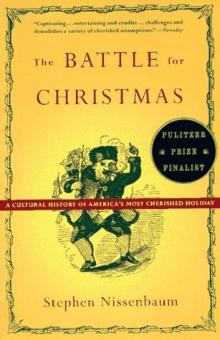Read The Battle for Christmas Storyline:
Amazon.com ReviewThis scholarly analysis of our modern celebration of Christmas pulls together a thoroughly convincing case for the widely accepted notion that it is a 19th-century creation, indeed a deliberate reformation and taming of a holiday with wilder pagan origins. Christmas was set at December 25 in the fourth century, not for any biblical link with Christ's birth, but because the church hoped to annex and Christianize the existing midwinter pagan feast. This latter was based on the seasonal agricultural plenty, with the year's food supply newly in store, and nothing to do in the fields. It was a time of drinking and debauchery from the Roman Saturnalia to the English Mummers. The Victorians hijacked the holiday, and Victorian writers helped turn it into a feast of safe domesticity and a cacophonous chime of retail cash registers. From Publishers WeeklyChristmas in America hasn't always been the benevolent, family-centered holiday we idealize. The Puritans of the Massachusetts Bay Colony so feared the day's association with pagan winter solstice revels, replete with public drunkenness, licentiousness and violence, that they banned Christmas celebrations. In this ever-surprising work, Nissenbaum (Sex, Diet, and Debility in Jacksonian America), a professor of history at the University of Massachusetts, conducts a vivid historical tour of the holiday's social evolution. Nissenbaum maintains that not until the 1820s in New York City, among the mercantile Episcopalian Knickerbockers, was Christmas as we know it celebrated. Before Washington Irving and Clement Clarke Moore ("A Visit from St. Nicholas") popularized the genteel version, he explains, the holiday was more of a raucous festival and included demands for tribute from the wealthy by roaming bands of lower-class extortionists. Peppering his insights with analysis of period literature, art and journalism, Nissenbaum constructs his theory. Taming Christmas, he contends, was a way to contain the chaos of social dislocation in a developing consumer-capitalist culture. Later, under the influence of Unitarian writers, the Christmas season became a living object lesson in familial stability and charity, centering on the ideals of bourgeois childhood. From colonial New England, through 18th- and 19th-century New York's and Philadelphia's urban Yuletide contributions, to Christmas traditions in the antebellum South, Nissenbaum's excursion is fascinating, and will startle even those who thought they knew all there was to know about Christmas. Illustrations. Copyright 1996 Reed Business Information, Inc.Pages of The Battle for Christmas :
